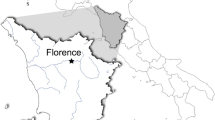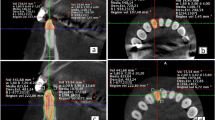Abstract
This paper presents the first ever paleodontological investigation of human remains from an archeological site in Central Europe dating from the Early Bronze Age and attributed to the Strzyzow Culture. It corroborates the knowledge gained from archeological, anthropological and genetical investigations. Our study aimed to assess dental status, dental morphology and dental pathologies as well as tooth wear and enamel hypoplasia based on visual inspection and stereomicroscopic investigation. The research was supported by CBCT imaging to obtain digital images and 3D reconstructions as well as 2D radiographs essential for dental age estimation. All of the 191 teeth discovered showed morphological similarity, with adult teeth showing similar color, shape and size. A maxillary molar presenting with a unique root morphology and a mandibular molar with a rare occlusal surface were found. Both permanent and deciduous dentition presented significant tooth wear. A few specimens displayed signs of dental caries, periapical pathology and antemortem tooth loss. Three individuals exhibited linear enamel hypoplasia. CBCT provided high-quality 2D images useful for dental age estimation by non-destructive methods. Estimated dental age correlated with the age estimated by other anthropological methods. In one case, this was crucial because of insufficient material for anthropological analysis. The presented studies have proved that besides the skeleton, teeth can be used as a fundamental tool in assessing the overall health and living conditions of paleopopulations. It would seem that there is potential for considerable development to be made in the research and investigation of paleodontological material using CBCT.








Similar content being viewed by others
Notes
Ritual burning of bodies have been recorded in the Strzyzow Culture.
References
Olsen BD. Understanding human anatomy through evolution. 2nd ed. Bruce D. Olsen; 2009.
Seiler R, Spielman AI, Zink A, Rühli F. Oral pathologies of the Neolithic Iceman, c.3,300 BC. Eur J Oral Sci. 2013;121:137–41.
Lorkiewicz W. Nonalimentary tooth use in the Neolithic population of the Lengyel Culture in Central Poland (4600–4000 BC). Am J Phys Anthropol. 2011;144:538–51.
Bernhard W. Anthropological studies on the mummy from the Ötztal Alps. Coll Anthropol. 1994;18:241–67.
Niklisch N, Ganslmeier R, Siebert A, Friedrich S, Meller H, Alt KW. Holes in teeth-dental caries in Neolithic and Early Bronze Age populations in Central Germany. Ann Anat. 2015 [in press].
Lanfranco LP, Eggers S. Caries through time: an anthropological overview, contemporary approach to dental caries. In: Ming-Yu Li, editor. Contemporary approach to dental caries. InTech; 2012. pp.1–33.
Temple DH. Patterns of systematic stress during the agricultural transition in prehistoric Japan. Am J Phys Anthropol. 2010;142:112–24.
Tomczyk J, Tomczyk-Gruca M, Zalewska M. Frequency and chronological distribution of linear enamel hypoplasia (LEH) in the Late Neolithic and Early Bronze Age population from Żerniki Górne (Poland)—preliminary report. Anthropol Rev. 2012;75:61–73.
Cesarani F, Martina MC, Ferraris A, Grilletto R, Boano R, Marochetti EF, Donadoni AM, Gandini G. Whole body 3D multidetector CT of 13 Egyptian human mummies. Am J Roentgenol. 2003;180:597–606.
Dedouit F, Géraut A, Baranov V, Ludes B, Rougé D, Telmon N, Crubézy E. Virtual and macroscopical studies of mummies-differences or complementarity? Report of a natural frozen Siberian mummy. Forensic Sci Int. 2010;200:e7–13.
Marx M, D’Auria SH. CT examination of eleven Egyptian mummies. Radiographics. 1986;6:321–30.
Ruff CB, Holt BM, Sladek V, Berner M, Murphy AW, zyr Nedden D, Seidler H, Recheis W. Body size, body proportions and mobility in the Tyrolean “Iceman”. J Hum Evol. 2006;51:91–101.
Gahleitner A, Watzek G, Imhof H. Dental CT: imaging technique, anatomy, and pathologic conditions of the jaws. Eur Radiol. 2003;13:366–76.
AlQahtani SJ, Hector MP, Liversidge HM. Brief communication: the London atlas of human tooth development and eruption. Am J Phys Anthropol. 2010;142:481–90.
Kvaal SI, Kolltveit KM, Thomsen IO, Solheim T. Age estimation of adults from dental radiographs. Forensic Sci Int. 1995;74:175–85.
Kullman L, Johanson G, Akesson L. Root development of the lower third molar and its relation to chronological age. Swed Dent J. 1992;16:161–7.
Demirjian A, Goldstein H, Tanner JM. A new system of dental age assessment. Hum Biol. 1973;45:211–27.
Moorrees CF, Fanning EA, Hunt EE. Age variation of formation stages for ten permanent teeth. J Dent Res. 1963;42:1490–502.
Woelfel JB, Scheid RC. Dental anatomy. Its relevance to dentistry. 5th ed. Williams & Wilkins, 1997.
Cleghorn BM, Christie WH, Dong CCS. Root and root canal morphology of the human permanent maxillary first molar: a literature review. J Endodont. 2006;32:813–21.
Shellis RP, Addy M. The interactions between attrition, abrasion and erosion in tooth wear. Monogr Oral Sci. 2014;25:32–45.
Barbour ME, Rees GD. The role of erosion, abrasion and attrition in tooth wear. J Clin Dent. 2006;17:88–93.
Lukacs JR, Pastor RF. Activity- induced patterns of dental abrasion in prehistoric Pakistan: evidence from Mehrgarh and Harappa. Am J Phys Anthropol. 1988;76:377–98.
Kieser JA, Preston CB. The dentition of the Lengua Indians of Paraguay. Am J Phys Anthropol. 1981;55:485–90.
Kieser JA, Dennison KJ, Kaidonis JA, Huang D, Herbison PGP, Tayles NG. Patterns of tooth wear in the early Maori dentition. Int J Osteoarchaeol. 2001;11:206–17.
Okeson JP. Management of temporomandibular disorders and occlusion. 7th ed. Mosby; 2013.
Lukacs JR. Sex differences in dental caries rates with the origin of agriculture in South Asia. Curr Anthropol. 1996;37:147–53.
Cucina A, Lucci M, Vargiu R, Coppa A. Dental evidence of biological affinity and environmental conditions in prehistoric Trentino (Italy) samples from the Neolithic to the Early Bronze Age. Int J Osteoarchaeol. 1999;9:404–16.
Tayles N, Domett K, Halcrow S. Can dental caries be interpreted as evidence of farming? The Asian experience. In: Koppe T, Meyer G, Alt KW, editors. Comparative dental morphology. Front Oral Biol. Basel: Karger; 2009; 13:162–6.
Goodman AH, Armelagos GJ, Rose JC. The chronological distribution of enamel hypoplasia from prehistoric Dickson Mounds populations. Am J Phys Anthropol. 1984;65:259–66.
Nanci A. Development of the tooth and its supporting tissues. In: Ten Cate’s Oral Histology. Development, Structure and Function. Chapter 1. St Louis, Missouri, Mosby Elsevier; 2008: p. 79–107.
Duray SM. Dental indicators of stress and reduced age at death in prehistoric native Americans. Am J Phys Anthropol. 1996;99:275–86.
Mol A, Balasundaram A. In vitro cone beam computed tomography imaging of periodontal bone. Dentomaxillofac Radiol. 2008;37:319–24.
Haiter-Neto F, Wenzel A, Gotfredsen E. Diagnostic accuracy of cone beam computed tomography scans compared with intraoral image modalities for detection of carious lesions. Dentomaxillofac Radiol. 2008;37:18–22.
Stavropoulos A, Wenzel A. Accuracy of cone beam dental CT, intraoral digital and conventional film radiography for the detection of periapical lesions. An ex vivo study in pig jaws. Clin Oral Invest. 2007;11:101–6.
Hassan B, Metska ME, Ozok AR, van der Stelt P, Wesselink PR. Comparison of five cone beam computed tomography systems for the detection of vertical root fractures. J Endod. 2010;36:126–9.
Moerenhout BA, Gelaude F, Swennen GR, Casselman JW, Van Der Sloten J, Mommaerts MY. Accuracy and repeatability of cone-beam computed tomography (CBCT) measurements used in the determination of facial indices in the laboratory setup. J Craniomaxillofac Surg. 2009;37:18–23.
Hannig C, Krieger E, Dullin C, Merten H-A, Attin T, Grabbe E, Heidrich G. Volumetry of human molars with flat panel-based volume CT in vitro. Clin Oral Invest. 2006;10:253–7.
Gustafson J. Age determination on teeth. J Am Dent Assoc. 1950;41:45–54.
Johanson G. Age determination from human teeth. Odontological Rev Suppl. 1971;21:1–126.
Lamendin H, Baccino E, Humbert JF, Travernier JC, Nossintchouk RM, Zerilli A. A simple technique for age estimation in adult corpses: the two criteria dental method. J Forensic Sci. 1992;37:1373–9.
Solheim T. A new method for dental age estimation in adults. Forensic Sci Int. 1993;59:137–47.
Liversidge HM. Timing of human mandibular third molar formation. Ann Hum Biol. 2008;35:294–321.
Haavikko K. Tooth formation age estimated on a few selected teeth. A simple method for clinical use. Proc Finn Dental Soc. 1974;70:15–9.
Keller EE, Sather AH, Hayles AB. Dental and skeletal development in various endocrine and metabolic diseases. J Am Dent Assoc. 1970;81:415–9.
Psoter W, Gebrian B, Prophete S, Reid B, Katz R. Effect of early childhood malnutrition on tooth eruption in Haitian adolescents. Community Dent Oral Epidemiol. 2008;36:179–89.
Acknowledgments
The authors would like to thank Mrs. Ruth Hounam for her language support.
Author information
Authors and Affiliations
Corresponding author
Ethics declarations
Conflict of interest
The authors declare that they have no conflict of interest.
Additional information
A. Przystańska and D. Lorkiewicz-Muszyńska equally contributed to the work.
Rights and permissions
About this article
Cite this article
Przystańska, A., Lorkiewicz-Muszyńska, D., Abreu-Głowacka, M. et al. Analysis of human dentition from Early Bronze Age: 4000-year-old puzzle. Odontology 105, 13–22 (2017). https://doi.org/10.1007/s10266-015-0220-7
Received:
Accepted:
Published:
Issue Date:
DOI: https://doi.org/10.1007/s10266-015-0220-7




